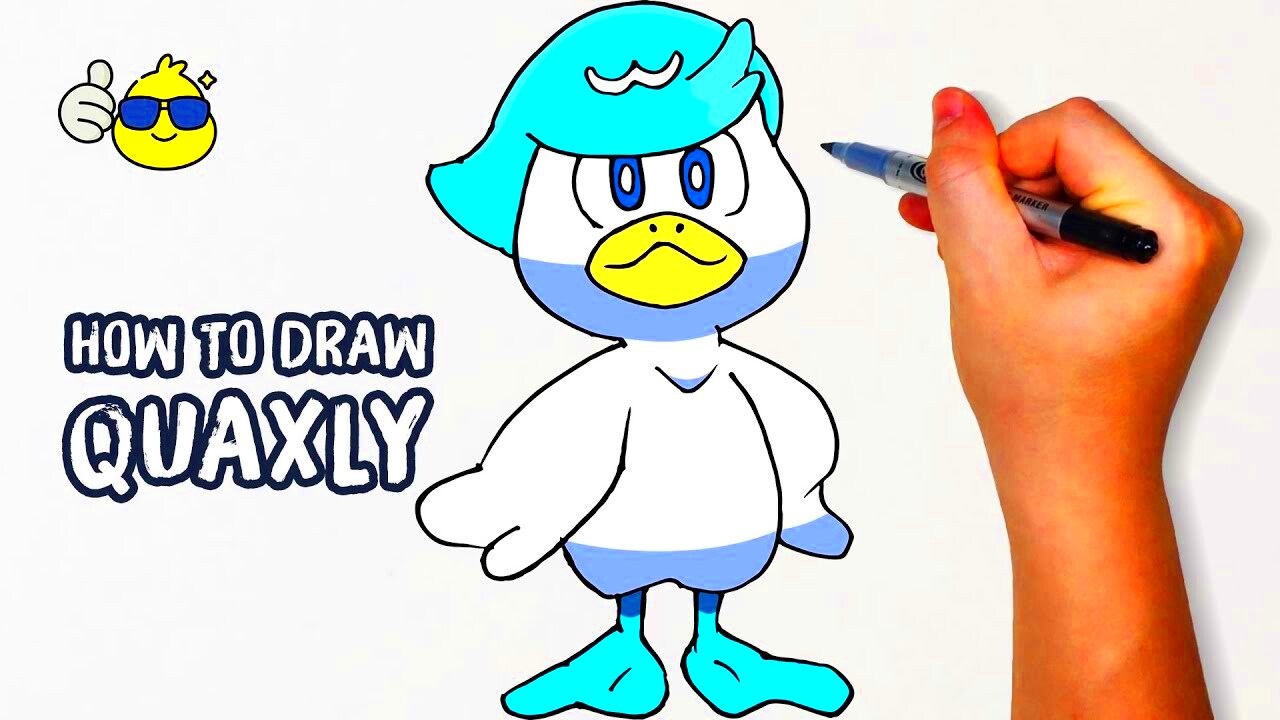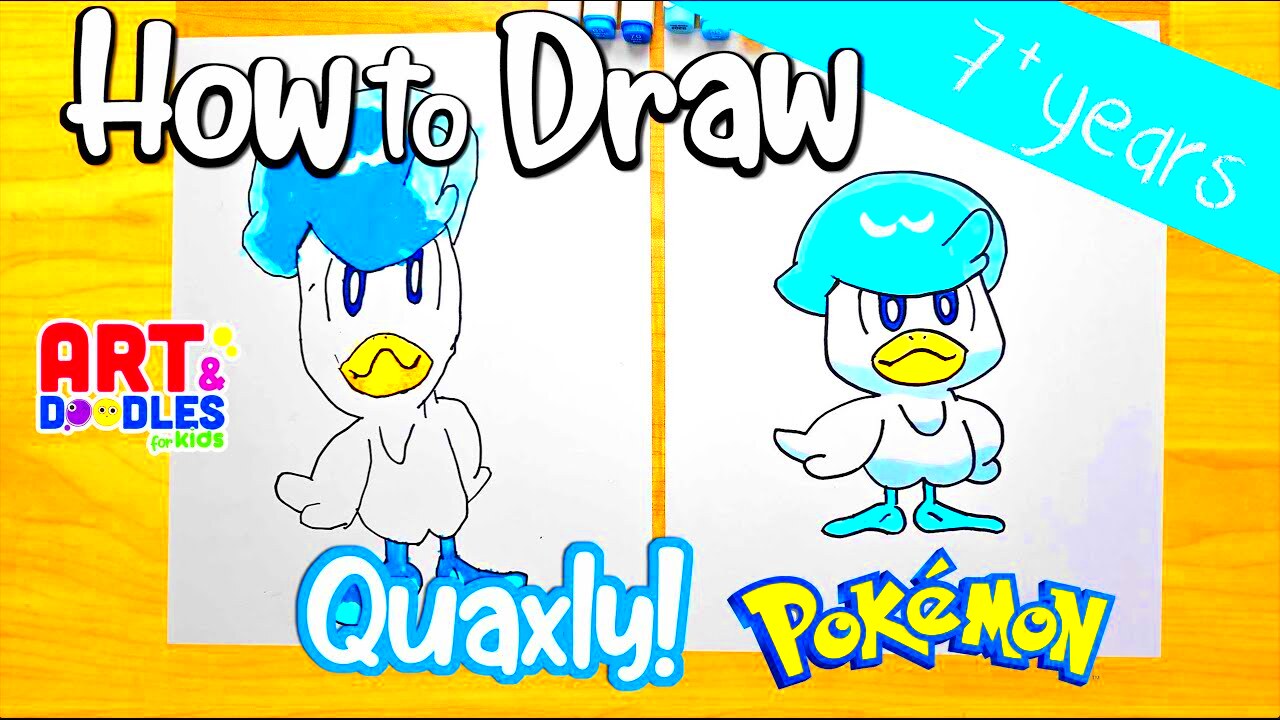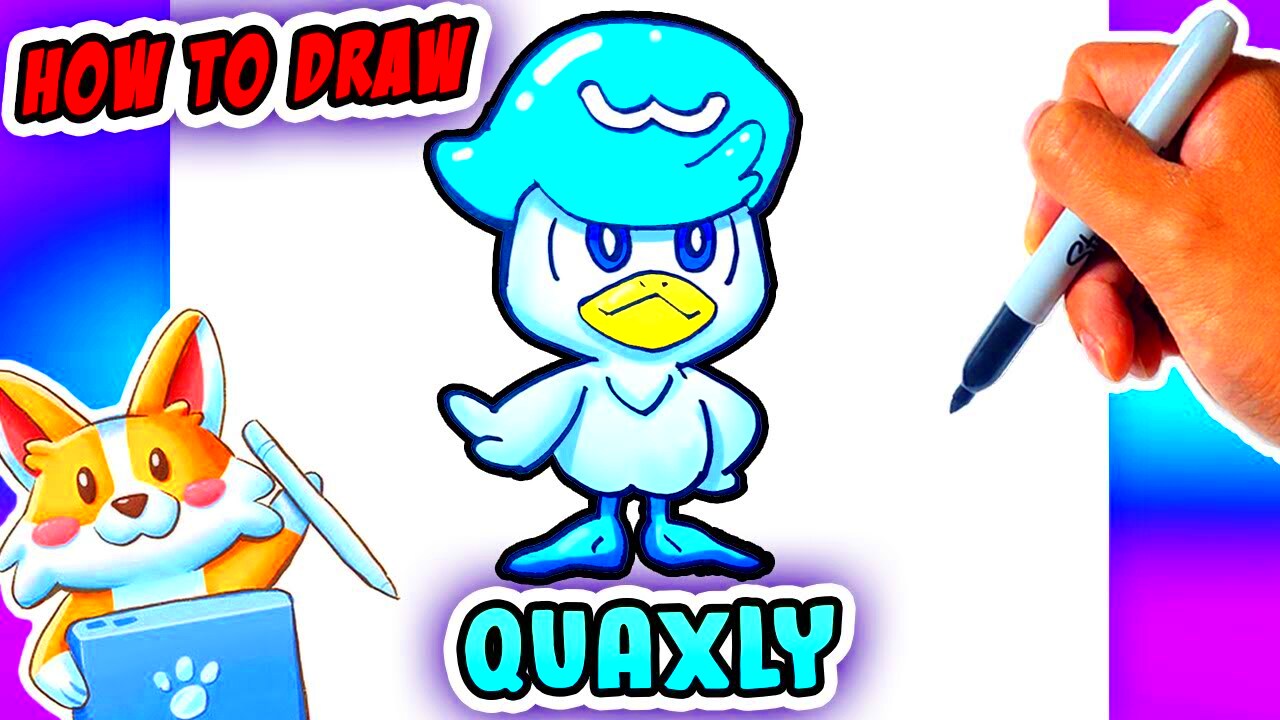Drawing Quaxly can be a fun and rewarding experience, especially if you are a fan of Pokémon or enjoy creating characters. This guide will take you through a simple, step-by-step process to draw Quaxly, focusing on key features and techniques to help you bring this character to life. Whether you're a beginner or someone with some drawing experience, you'll find helpful tips along the way.
Quaxly is a water-type Pokémon known for its charming design and vibrant personality. By following this guide, you'll learn how to break down the character into easy shapes, add details, and add the perfect finishing touches to make Quaxly look just right. Ready to start? Let’s dive in!
Understanding Quaxly's Features and Appearance

Before you begin drawing Quaxly, it’s important to understand what makes this character unique. Observing Quaxly’s features closely will help you capture its likeness with ease. Let’s break down its key attributes:
- Color Scheme: Quaxly has a bright blue body with a lighter blue on its chest and face. The contrasting colors make it stand out.
- Shape and Build: Quaxly has a rounded, almost oval body shape with a slender neck and legs.
- Facial Expression: Its face has an expressive, determined look with large eyes that add personality.
- Distinctive Features: Quaxly has a unique tuft of feathers on top of its head and around its neck that gives it a fun, quirky appearance.
By understanding these features, you can start to visualize Quaxly in a way that will make your drawing more accurate and realistic. Make sure to take note of the proportions and placement of these key elements to create a balanced and lifelike drawing.
Gathering Your Drawing Materials

To get started, you’ll need the right materials. Having the proper tools will make the drawing process smoother and more enjoyable. Here’s a list of basic supplies you should gather before you begin:
- Pencil: Start with a simple pencil for sketching. A 2B or HB pencil works great for outlines and initial shapes.
- Paper: Choose a clean, smooth piece of paper. A sketchbook or drawing pad is ideal.
- Eraser: A good eraser is essential for refining your work and correcting any mistakes.
- Colored Pencils or Markers: Once your outline is done, you’ll need colors to bring Quaxly to life. Select a blue set that includes a range of tones.
- Fine Liner Pen (optional): For detailing and outlining your drawing once it's finished, a fine liner pen can help define the edges of your drawing.
Having the right materials will help you work more efficiently and produce better results. Don’t worry if you don’t have the highest-quality tools—basic supplies can still yield great results with a little practice.
Step by Step Guide to Drawing Quaxly

Now that you understand Quaxly’s features and have your materials ready, it's time to start drawing. Don't worry—by following these easy steps, you'll be able to draw Quaxly in no time. Let’s break it down into simple stages:
- Start with Basic Shapes: Begin by lightly sketching Quaxly's basic shapes using a pencil. Draw an oval for the body and a smaller circle for the head. These shapes act as guidelines for the rest of your drawing.
- Draw the Outline of the Head: Add the outline of Quaxly’s head on top of the circle. Use soft, curved lines for a smooth, rounded look. Don’t forget its tuft of feathers on top!
- Add the Neck and Body: Extend the lines from the head to form Quaxly’s neck, then continue to sketch the rest of the body using gentle curves. It should look like an elongated oval.
- Outline the Arms and Legs: Now, sketch the arms and legs. Quaxly has simple, yet expressive limbs—short arms and longer, more defined legs.
- Sketch the Face and Expression: Add the eyes, beak, and small details like the feathers around the neck. Don’t forget Quaxly’s signature smile and determined eyes!
- Refine and Erase Guidelines: Once you’re happy with the basic shapes, carefully erase any unnecessary guidelines and refine the lines to match Quaxly’s final look.
At this stage, you should have a solid outline of Quaxly. Remember, this is just the beginning! Take your time and enjoy the process of adding more details in the next steps.
Adding Details to Make Quaxly Stand Out
Details are what make your drawing come to life! Quaxly has unique features that make it stand out, and adding these will give your drawing personality and depth. Let’s add some special touches:
- Facial Features: Quaxly’s large, expressive eyes are key to its charm. Add a circular shape for the eyes, leaving space for the pupil and a small highlight to bring them to life. For the beak, use small, curved lines to make it look sharp yet friendly.
- Feathers: Pay close attention to the feathers around Quaxly’s neck and head. Add a few wavy lines on the head to represent its feather tuft, and some spiky lines on the chest area to make the texture pop.
- Limbs: The arms and legs are short, but make sure to add some feather details near the shoulders and legs to match Quaxly's overall look. A few curved lines will do the trick!
- Tail Feathers: Don’t forget the tail feathers. They should be short, fanned-out lines at the back of Quaxly's body. Adding some texture to the tail will give it a more realistic and dynamic look.
These little details are crucial for making your drawing more dynamic. Focus on precision and take your time to get these right. Adding texture and definition to Quaxly’s feathers and body will make the drawing pop.
Coloring and Shading Techniques for Quaxly
Now that your outline and details are in place, it's time to add color and bring Quaxly to life! Coloring and shading can really elevate your drawing. Here are some tips to help you get it right:
- Base Color: Start with a light blue color for Quaxly's body. Use gentle, even strokes to fill in the entire body area. Don’t press too hard with your pencil or marker; you want a smooth base layer.
- Feather Shading: Use a darker blue or even a slightly purplish shade for the feathers. Add shading where the feathers overlap or where shadows might fall, like under the neck and wings. A little gradient from light to dark will make it look more 3D.
- Face Details: For Quaxly’s face, color the eyes a deep brown or black for the pupils, leaving a tiny white spot to create the reflection. The beak should be a bright yellow or orange to contrast with the blue body.
- Adding Depth with Shadows: Use a slightly darker blue or even gray to create shadows along the edges of Quaxly’s body and legs. Light shading under the neck and tail can add volume and make the drawing feel more lifelike.
- Final Touches: Use a white or very light blue pencil or marker to add highlights to the feathers and around the eyes. This will give your drawing some extra shine and definition.
Shading and coloring Quaxly can really make your drawing pop! Be sure to blend the colors smoothly to avoid harsh lines, and don’t forget to experiment with different shades to find the perfect look for your drawing.
Final Touches to Complete Your Drawing
Once you’ve finished drawing and coloring Quaxly, it’s time to add the final touches that will make your artwork shine. These small but important details will bring your drawing to life and give it a polished look. Let’s go through what you can do to complete your drawing:
- Refine the Outlines: Take a fine liner or darker pencil to go over the outlines of Quaxly, especially the features that need to stand out. This helps define the shapes and brings clarity to your drawing.
- Add Highlights: Use a white or light-colored pencil to add highlights to Quaxly's feathers, eyes, and beak. These small touches give the drawing depth and make it look shiny and fresh.
- Soften the Shading: If any areas look too harsh or unnatural, use a blending tool or your finger to soften the shading. This creates smooth transitions between light and dark areas, making Quaxly look more realistic.
- Check for Symmetry: Step back and look at your drawing as a whole. Ensure that Quaxly’s features are balanced and symmetrical, like the placement of the wings, eyes, and beak.
- Final Adjustments: Lastly, make any small adjustments to improve the drawing, whether it’s adding more texture to the feathers or enhancing the color in specific areas. This will help make your drawing more dynamic and vibrant.
Don’t rush these last steps—take your time to ensure that your final touches give your drawing a clean, professional finish. With patience, your Quaxly drawing will look stunning!
Tips for Improving Your Drawing Skills
Improving your drawing skills takes time and practice, but there are a few helpful tips that can speed up your progress. Whether you’re new to drawing or just looking to get better, these strategies will help you refine your technique:
- Practice Regularly: The more you draw, the better you’ll become. Try to draw something every day, even if it’s just a quick sketch. Consistency is key to improving.
- Break Down Complex Shapes: When drawing a character like Quaxly, break it down into simpler shapes, like circles and ovals. This makes the process less intimidating and helps you build accurate proportions.
- Study Real-life References: Look at real birds or other characters to understand how features like feathers, beaks, and eyes are structured. This will improve your ability to add realistic details to your drawings.
- Experiment with Different Mediums: Try using different drawing tools, such as colored pencils, pens, or markers, to find out which works best for you. Experimenting can help you discover new techniques.
- Ask for Feedback: Show your drawings to friends, family, or online communities and ask for feedback. Constructive criticism can help you spot areas for improvement.
With time, patience, and practice, you’ll notice a significant improvement in your drawing abilities. Keep learning and experimenting—drawing is all about having fun and expressing your creativity!
Frequently Asked Questions
Many people have similar questions when it comes to drawing characters like Quaxly. Below are answers to some common queries to help guide you on your drawing journey:
- How long does it take to draw Quaxly? The time it takes to draw Quaxly depends on your skill level and the detail you put into the drawing. On average, it can take anywhere from 1 to 3 hours, including shading and coloring.
- What if I make a mistake while drawing? Don’t worry about mistakes! Simply erase the error and try again. Drawing is a process, and mistakes help you learn. Practice makes perfect!
- Can I use digital tools to draw Quaxly? Absolutely! If you prefer digital drawing, you can use drawing software like Procreate or Photoshop. Many of the same steps apply, such as sketching basic shapes, refining outlines, and adding color and shading.
- Do I need advanced drawing skills to draw Quaxly? Not at all! Quaxly is a great character to draw for beginners because its shapes are simple, and the process is easy to follow. As long as you take your time and follow the steps, you can create a great drawing.
- What colors should I use for Quaxly? Quaxly’s main color is a bright blue, with lighter shades for the chest and face. For the beak and eyes, use yellow, orange, and black. Use varying shades to add depth and dimension to your drawing.
Conclusion
Drawing Quaxly can be a fun and rewarding project for artists of all levels. By following the step-by-step guide, adding details, and using shading and coloring techniques, you can create a beautiful and lifelike drawing of this beloved character. Remember, practice is essential to improving your skills, so keep drawing and experimenting with new techniques.
Whether you’re a beginner or an experienced artist, drawing Quaxly will help you develop your artistic abilities and give you a sense of accomplishment. So, grab your materials, follow the steps, and let your creativity shine!
Conclusion
Drawing Quaxly is a fun and rewarding process that allows you to explore your creativity while developing your artistic skills. By following the steps in this guide—starting from the basic shapes to adding details, coloring, and shading—you can create a dynamic and lifelike version of this charming character. Remember, the key to improvement is practice, so don't worry if your first attempt isn't perfect. Every drawing teaches you something new, and with time, your technique will continue to evolve.
With each sketch, you’ll become more confident in your abilities. Whether you’re drawing for fun, improving your skills, or working on a specific project, Quaxly is a great character to help you refine your craft. So keep practicing, enjoy the process, and most importantly—have fun with your art!











